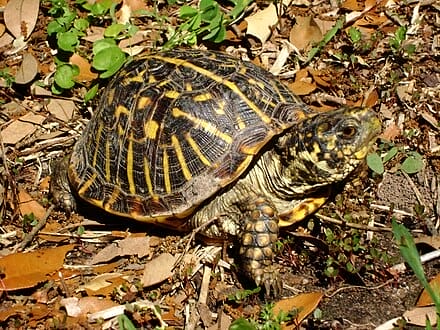Terrapene ornata (Ornate Box Turtle)
Home > Turtle Database > Terrapene ornata (Ornate Box Turtle)
Terrapene ornata, commonly known as the ornate box turtle, is a small, terrestrial turtle native to North America. Recognized for its striking yellow and black patterned shell, this species is well-adapted to dry grasslands and prairies, where it spends much of its life burrowed underground.
Native To These Regions
Arizona (USA), Colorado (USA), Iowa (USA), Kansas (USA), Missouri (USA), Nebraska (USA), New Mexico (USA), Oklahoma (USA), South Dakota (USA), Texas (USA), Wyoming (USA)Native Turtle Species Map – Find Turtles by Region
Scientific Classification
Kingdom: Animalia
Phylum: Chordata
Class: Reptilia
Order: Testudines
Family: Emydidae
Genus: Terrapene
Species: T. ornata
Common Names
Ornate Box Turtle
Western Box Turtle
This Hilarious Turtle Book Might Know Your Pet Better Than You Do
Let’s be real—most turtle care guides feel like reading a textbook written by a sleep-deprived zookeeper.
This one’s not that.
Told from the snarky point of view of a grumpy, judgmental turtle, 21 Turtle Truths You’ll Never Read in a Care Guide is packed with sarcasm, sass, and surprisingly useful insights.
And hey—you don’t have to commit to the whole thing just yet.
Grab 2 free truths from the ebook and get a taste of what your turtle really thinks about your setup, your food choices, and that weird plastic palm tree.
It’s funny, it’s honest, and if you’ve ever owned a turtle who glares at you like you’re the problem—you’ll feel seen.
Identification
Description
The ornate box turtle has a domed, oval-shaped carapace with bold yellow or orange lines radiating from the center of each scute. The plastron is usually dark with lighter markings. Adults typically reach 4-6 inches in length. Their skin is dark brown to black with yellow or orange speckling.
Sexual Dimorphism
Males often have red or orange eyes, while females usually have brown or yellow eyes. Males also have a slightly concave plastron and longer, thicker tails.
Check more turtles from the Terrapene genus
Native Origin and Distribution
Geographical Range
This species is native to the central United States, primarily in the Great Plains region. It is found from South Dakota and Nebraska down to Texas, with populations also present in parts of Colorado, Kansas, Oklahoma, and Missouri.
Preferred Habitat
Ornate box turtles thrive in open grasslands, prairies, and sandy areas with sparse vegetation. They prefer dry environments with loose soil, which allows them to burrow for shelter and temperature regulation.
Behavior
Feeding Habits
Omnivorous by nature, they consume a mix of insects, earthworms, small vertebrates, berries, mushrooms, and vegetation. They actively forage during the morning and evening but seek shelter during the hotter parts of the day.
Predators
Common predators include raccoons, skunks, foxes, coyotes, and birds of prey. Hatchlings and juveniles are especially vulnerable to predation.
Reproduction
Breeding Season
Mating occurs in spring and early summer, shortly after emerging from brumation.
Reproductive Method
Females lay 2-8 eggs in sandy or loose soil, typically in early summer. The eggs incubate for about 60-80 days, with hatchlings emerging in late summer or early fall. Temperature determines the sex of the offspring, a phenomenon known as temperature-dependent sex determination.
Conservation
Extinction Status
Listed as Near Threatened in some areas due to habitat destruction and collection for the pet trade.
Threats
The biggest threats include habitat loss due to agriculture and urban development, road mortality, and illegal poaching. Pesticides and climate change also impact their populations.
Conservation Measures
Protected under state laws in several regions. Conservation efforts focus on habitat preservation, captive breeding programs, and public awareness campaigns to reduce illegal collection.
Economic Importance
Ornate box turtles contribute to ecosystem health by controlling insect populations and dispersing seeds. They are also kept as pets, though wild collection is discouraged.
Interesting Facts
- Unlike aquatic turtles, ornate box turtles rely on their strong, hinged plastron to close their shell completely for protection.
- They can live for over 30 years in the wild, with some reaching 50 years in captivity.
- During extreme heat or cold, they burrow underground to regulate body temperature, a behavior known as aestivation or brumation.
- They have a strong homing instinct and often try to return to their original habitat if relocated.

About Author
Muntaseer Rahman started keeping pet turtles back in 2013. He also owns the largest Turtle & Tortoise Facebook community in Bangladesh. These days he is mostly active on Facebook.















